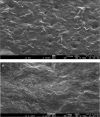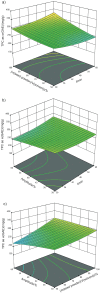Optimisation of Ultrasound-Assisted Extraction Conditions Using Response Surface Methodology and Identification of Thymoquinone from Black Cumin (Nigella sativa L.) Seed Extract§
- PMID: 40735154
- PMCID: PMC12270582
- DOI: 10.17113/ftb.63.02.25.8560
Optimisation of Ultrasound-Assisted Extraction Conditions Using Response Surface Methodology and Identification of Thymoquinone from Black Cumin (Nigella sativa L.) Seed Extract§
Abstract
Research background: Nigella sativa L., commonly known as black cumin, is a medicinal plant renowned for its rich bioactive composition and health-promoting properties. Among its key compounds, thymoquinone has gained significant attention in nutraceutical and pharmaceutical research for its potential to prevent and manage chronic inflammatory conditions and immune dysfunctions. With growing global interest in natural health solutions, the aim of this study is to optimise ultrasound-assisted extraction (UAE) conditions to maximise thymoquinone yield from the extract of black cumin (Nigella sativa L.) seeds and characterise the bioactive compounds. By using UAE and advanced analytical techniques, the research contributes to the development of sustainable extracts rich in bioactive compounds with applications in medicine and nutrition.
Experimental approach: In this study, ultrasound-assisted extraction method was used with response surface methodology (RSM) software to extract the bioactive compounds, including total phenolic content (TPC) and compounds that can bind free DPPH radical. To increase the extraction efficiency of bioactive compounds, the following parameters were examined: the ratio of the mass of seed powder to the volume of solvent of 50-100 %, extraction temperature of 30 °C, amplitude of 30-60 % and extraction time of 30-60 min. Black cumin seed extracts were characterised using scanning electron microscopy (SEM), while gas chromatography-mass spectrometry (GC-MS) analysis was carried out to identify thymoquinone. Additionally, Fourier transform infrared (FTIR) spectroscopy confirmed the presence of thymoquinone and several functional groups, including amines, alkanes, acids, esters, alkyls and alkenes.
Results and conclusions: Ultrasonic extraction using methanol as a solvent resulted in a higher yield of thymoquinone (28.62 %), identified using GC-MS analysis. The presence of thymoquinone was further confirmed by the functional groups detected in FTIR analysis. Under the specified extraction conditions, total phenolic content (TPC, expressed as gallic acid equivalents), yield (in %) and DPPH radical scavenging activity increased by approx. 271.03 mg/g, and 4.5 and 83.06 %, respectively. In addition to thymoquinone, thymohydroquinone was also identified based on its molecular mass, retention time and peak values. Thymoquinone, a natural and potent phytochemical, offers a range of therapeutic properties, including immune-enhancing potential.
Novelty and scientific contribution: Thymoquinone is a bioactive compound found in black cumin seeds, known for its potent antioxidant and immunity boosting properties. This research was conducted achieve the best possible extraction conditions for bioactive substances. Additionally, the results support the potential of thymoquinone as a therapeutic agent to treat various health conditions. The novelty lies in the development and optimisation of extraction techniques to maximise the yield and bioactivity of thymoquinone, a compound renowned for its robust antioxidant and immune-modulating properties. This work uniquely bridges the gap between the traditional use of black cumin and modern scientific validation, and addresses global health priorities. The results emphasise the importance of Nigella sativa as a sustainable and natural source of health-promoting compounds, meeting the increasing demand for plant-based bioactive compounds in preventive healthcare. By characterising the extraction conditions and demonstrating therapeutic potential of thymoquinone, this study contributes to both the scientific literature and practical advances in the development of functional food and nutraceuticals.
Keywords: FTIR analysis; GC-MS analysis; antioxidant potential; black cumin; thymoquinone identification; ultrasonic extraction optimisation.
Authors.
Conflict of interest statement
CONFLICT OF INTEREST The authors declare no conflict of interests.
Figures






Similar articles
-
Optimization of ultrasonic-assisted extraction of phenolic compounds from Clinacanthus nutans using ionic liquid (ILs) binary solvent: Application of Peleg's model and response surface methodology.PLoS One. 2025 Jul 3;20(7):e0326141. doi: 10.1371/journal.pone.0326141. eCollection 2025. PLoS One. 2025. PMID: 40608755 Free PMC article.
-
Innovative Cold Plasma Pretreatment and Enzyme-Assisted Extraction of Genistein from Edamame and Storage Stability of Dried Extract Powder.Foods. 2025 Jun 17;14(12):2118. doi: 10.3390/foods14122118. Foods. 2025. PMID: 40565731 Free PMC article.
-
Management of urinary stones by experts in stone disease (ESD 2025).Arch Ital Urol Androl. 2025 Jun 30;97(2):14085. doi: 10.4081/aiua.2025.14085. Epub 2025 Jun 30. Arch Ital Urol Androl. 2025. PMID: 40583613 Review.
-
Role of Nigella sativa L. seed (black cumin) in preventing photoaging (Review).Biomed Rep. 2025 Jun 4;23(2):131. doi: 10.3892/br.2025.2009. eCollection 2025 Aug. Biomed Rep. 2025. PMID: 40530399 Free PMC article. Review.
-
Development and Application of a Novel 'Green' Antibacterial Black Garlic (Allium sativum)-Based Nanogel in Epidermal Wound Healing§.Food Technol Biotechnol. 2025 Jun;63(2):177-189. doi: 10.17113/ftb.63.02.25.8873. Food Technol Biotechnol. 2025. PMID: 40735159 Free PMC article.
References
-
- Alam I, Shahi NC, Lohani UC, Kumar A, Prakash O. Ultrasound assisted extraction of oil from black cumin (Nigella sativa L.). Int J Chem Stud. 2021;9(2):87–91. 10.22271/chemi.2021.v9.i2b.11698 - DOI
-
- Kaushik N, Barmanray A. A study on physico-chemical properties and nutritional profile of an indigenous cultivar - Black cumin (Nigella sativa L.). Int J Food Nutri Sci. 2022;11 S1:379–91.
-
- Dubey PN, Singh B, Mishra BK, Kant K, Solanki RK. Nigella (Nigella sativa): A high value seed spice with immense medicinal potential. Indian J Agric Sci. 2016;86(8):967–79. 10.56093/ijas.v86i8.60500 - DOI
LinkOut - more resources
Full Text Sources
Miscellaneous
